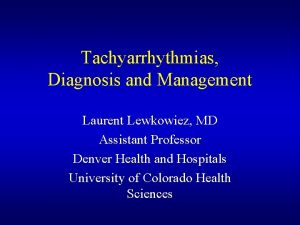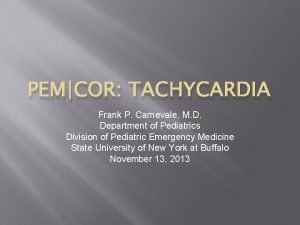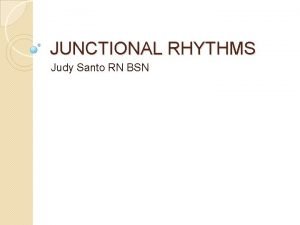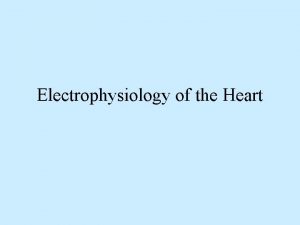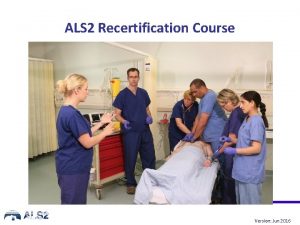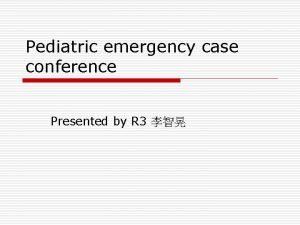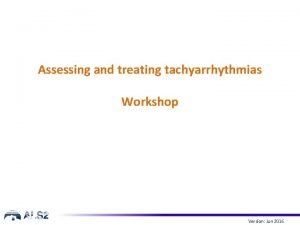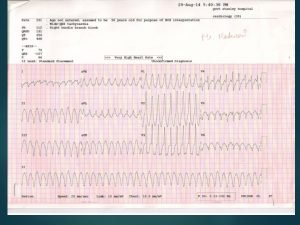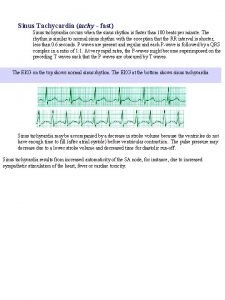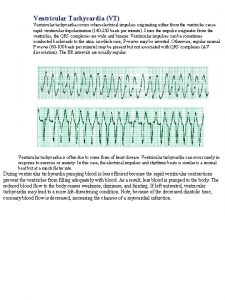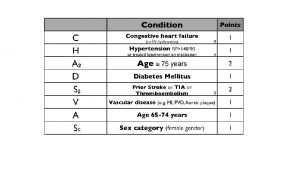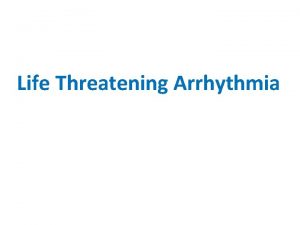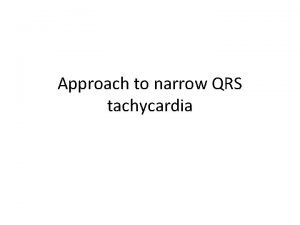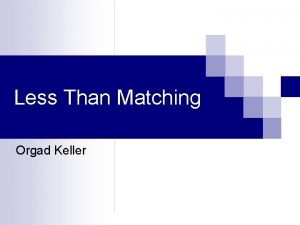APPROACH TO TACHYCARDIA Goals To make tachycardia less























- Slides: 23

APPROACH TO TACHYCARDIA

Goals § To make tachycardia “less scary” § To give you an approach to tachycardia § Pearls of interpretating 12 -2 -9

Tachycardia • • Definition – HR > 100 bpm – Or Cycle Length < 600 msec Narrow complex tachycardia – • QRS < 120 msec Wide complex tachycardia – QRS > 120 msec

Narrow Complex Tachycardia What are the questions to ask? § Is the rhythm regular or irregular? § Is there P with everything QRS or is P > QRS? § § How did the tachycardia start, with PAC or PVCs? How did the tachycardia terminate, with P or QRS?

Sinus tachycardia There is one P with one QRS §Regular rhythm §

Atrial Flutter More P then QRS, 3: 1, 4: 1 ratio § Regular Rhythm § Saw tooth appearance §

Atrial Tachycardia P before QRS. (may have different p morphology) • May be indistinguishable from sinus tachycardia • Usually abrupt onset and offset (as opposed to gradual with sinus tachycardia •

Multifocal atrial tachycardia • One P wave with one QRS • Irregular rhythm • Varying p wave morphology and PR segments • Usually Seen in patients with lung disease

Questions? 12 -2 -9

Atrial fibrillation No clear visible P waves § Irregular rhythm §

Atrial Fibrillation

Supraventricular tachycardia Narrow complex, regular § Starts and stops suddenly, usually with PAC § May see inverted p waves in the ST segment or T wave §

Narrow Complex Tachycardia Regular P before QRS: Sinus tachy Atach Aflutter with 1: 1 AV P>QRS: Aflutter Irregular No p wave: SVT Atach ? very fast AFIB Irregularly Irregular: Regularly Irregular: • Afib • Aflutter with variable • Multifocal Atach response • Atach with var response

Questions? Click to edit the outline text format Second Outline Level Third Outline Level 12 -2 -9 Fourth Outline Level Fifth Outline Level Sixth

WIDE COMPLEX TACHYCARDIAS

Ventricular tachycardia

Ventricular tachycardia Wide complex tachycardia • May be monomorphic or polymorphic • Usually preceded by PVC • Look for more QRS then P •

Polymorphic VT/Torsade de Pointes Classic pattern of “twisting” of QRS in an axis • Can be seen with electrolyte abnormalities- Hypo K, Hypo Mg or Long QT syndrome • Typical onset- bradycardia, long R-R interval followed by premature ventricular complex (PVC) •

SVT with Aberrancy SVT with native bundle branch block or rate-related aberrancy • May be difficult to distinguish VT from SVT with aberrancy even with most skilled Electrophysiologists •

Ventricular Fibrillation No clear visible P §Very fast > 300 bpm §

** This may not be ASYSTOLE • ALWAYS check that leads are properly put on • ALWAYS check gain is not too low!

Wide Complex tachycardia

Questions ?
 Strategic goals tactical goals operational goals
Strategic goals tactical goals operational goals Strategic goals tactical goals operational goals
Strategic goals tactical goals operational goals Less religious and less idealized than greek art
Less religious and less idealized than greek art General goals and specific goals
General goals and specific goals Motivation in consumer behaviour
Motivation in consumer behaviour Orthodromic reciprocating tachycardia
Orthodromic reciprocating tachycardia Pals tachycardia algorithm
Pals tachycardia algorithm Junctional tachycardia dysrhythmia
Junctional tachycardia dysrhythmia Coarse v fib
Coarse v fib Narrow qrs complex
Narrow qrs complex Jessica schwenk
Jessica schwenk Acls tachycardia
Acls tachycardia Als2 bradycardia algorithm
Als2 bradycardia algorithm Tachycardia treatment
Tachycardia treatment Junctional tachycardia
Junctional tachycardia Als2 tachycardia algorithm
Als2 tachycardia algorithm Stealing a speech entirely from a single source
Stealing a speech entirely from a single source A switch in a datagram network uses a
A switch in a datagram network uses a Theoretical models of counseling
Theoretical models of counseling Fine-grained screening
Fine-grained screening Multiple approach avoidance conflict
Multiple approach avoidance conflict Bandura's reciprocal determinism
Bandura's reciprocal determinism Research approaches definition
Research approaches definition Traditional approach in system analysis and design
Traditional approach in system analysis and design





